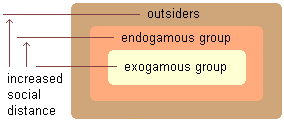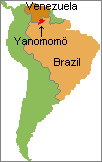There are two universal categories
of marriage partner selection restrictions. They
are referred to by anthropologists as
exogamy
 and endogamy
and endogamy
 rules. Exogamy rules require
that marriage be outside of some defined social group,
such as one's own family. In contrast, endogamy
rules require that it be within some larger group,
such as the local community. In other words,
rules of exogamy tell you who you cannot marry, while rules of endogamy specify who would be acceptable and
preferred as a marriage partner. Both of these types of rules
operate at the same time.
rules. Exogamy rules require
that marriage be outside of some defined social group,
such as one's own family. In contrast, endogamy
rules require that it be within some larger group,
such as the local community. In other words,
rules of exogamy tell you who you cannot marry, while rules of endogamy specify who would be acceptable and
preferred as a marriage partner. Both of these types of rules
operate at the same time.

Social distance is the key factor in this determination. Incest taboos
exclude close relatives (the exogamous
 group). Beyond that group are more distant
relatives, friends, and associates (the endogamous
group). Beyond that group are more distant
relatives, friends, and associates (the endogamous
 group) with whom marriage is usually
desirable. More distant still are all outsiders or aliens with whom marriage and
sexual relations are by and large either discouraged or forbidden.
group) with whom marriage is usually
desirable. More distant still are all outsiders or aliens with whom marriage and
sexual relations are by and large either discouraged or forbidden.
| |
|
 |
Traditional wedding
in Punjab,
India |
|
In North
America, the exogamous group includes an individual's siblings, parents,
grandparents, uncles, aunts, and sometimes cousins. There often are explicit incest
laws prohibiting marriage or mating with these relatives. The endogamous group
generally consists of the members of an individual's ethnic/racial, religious,
socio-economic and/or age groups. The North American endogamy rules, which
encourage marriage within these groups, are usually in the form of implicit social
pressure by friends and relatives. These rules may remain unstated below the surface
until an individual tries to deviate from them.
About 30% of all cultures
define some cousins as preferred mates. In other words, the endogamous group
includes relatives outside of the nuclear family
but not more distant than cousins. In the rural areas of India, Pakistan, and Bangladesh,
it is not unusual to find that a third of marriages are with first cousins. The
rate is even higher in some Middle Eastern
nations. Roughly half of the marriages are with first cousins in much
of the Arabian Peninsula, especially in the south. Among
the Bedouin Arabs
 , for instance, marriage partner preference is specifically for a
patrilateral
parallel cousin
, for instance, marriage partner preference is specifically for a
patrilateral
parallel cousin
 (father's brother's child). To understand this preference, it is
first necessary to know that Bedouins traditionally determine kinship patrilineally
(father's brother's child). To understand this preference, it is
first necessary to know that Bedouins traditionally determine kinship patrilineally
 --that
is, only from males to their offspring. The red people in the diagram are all
related patrilineally.
--that
is, only from males to their offspring. The red people in the diagram are all
related patrilineally.
Due to Yanomam
intermarriages in previous generations, ego's wife is not only his father's sister's
daughter but also is likely to be his mother's brother's daughter. Study the diagram
above to assure yourself that this could be the case. Since one's spouse is often
related on both sides of the family, it is essentially a bilateral cross cousin
 marriage
pattern. The net result is reinforcement each generation of ties between paired
lineages that assures dependable allies in the frequent Yanomom intervillage raiding and
internal village squabbles.
marriage
pattern. The net result is reinforcement each generation of ties between paired
lineages that assures dependable allies in the frequent Yanomom intervillage raiding and
internal village squabbles.
Number of
Spouses Permitted
How many spouses an individual is
allowed to have varies from culture to culture. The rule that is familiar to North Americans
and Europeans is monogamy--that is, one man married to one woman. While this
is now by far the most common form of marriage around the world, it is, in a sense, the
least preferred. In a sample of 850 societies, less than 20% preferred monogamy over
other marriage patterns.
| |
 |
A Greek coffee house
(traditional male bastion
in conservative villages) |
|
In North America and most
other large-scale industrial societies where remarriage is permitted after divorce or
death of a spouse, there often is serial monogamy--that is, marriage to multiple
spouses, but only one at a time. However, in Greek
villages, women traditionally have been socially prohibited from marrying again after the
death of their husbands. On becoming widows, they are thought to rapidly go
through menopause making them less desirable as potential
wives for most men. Widows take on a somewhat sexually neutral status and, therefore,
are free for the first time in their lives to go into male places, such as coffee houses.
However, they must wear black clothes to indicate their widow status for the rest
of their lives. Greek men who become widowers are not similarly restricted and
stigmatized as being gender neutral.
Polygamy
 , the
marriage of more than one spouse at a time, has been popular on all continents except
Europe. Surprisingly, it is often popular even among women in some societies.
When most people think of polygamy, they assume that it is a pattern in which a number of
women share the same husband. This relatively common form of polygamy is known as
polygyny
, the
marriage of more than one spouse at a time, has been popular on all continents except
Europe. Surprisingly, it is often popular even among women in some societies.
When most people think of polygamy, they assume that it is a pattern in which a number of
women share the same husband. This relatively common form of polygamy is known as
polygyny
 .
However, a rarer form, known as polyandry
.
However, a rarer form, known as polyandry
 , occurs when several husbands share the
same wife. Both forms of polygamy have advantages and disadvantages over monogamy
in their particular cultural settings.
, occurs when several husbands share the
same wife. Both forms of polygamy have advantages and disadvantages over monogamy
in their particular cultural settings.
| |
 |
Polygynous family in
Nigeria |
|
Polygyny is most
common today in Moslem nations, among cattle herding societies of East Africa,
and in the remnants of the old kingdoms of West Africa. The rationale for a man to
have more than one wife is usually a combination of more sexual partners, more children,
and, above all, increased social prestige. However, the European belief that polygyny is nothing more than the exploitation of women and that wives in a polygynous
 household are weak is somewhat of an ethnocentric projection that does not fit the reality
in all societies.
household are weak is somewhat of an ethnocentric projection that does not fit the reality
in all societies.
 |
|
|
Among
the Turkana
 of Kenya, for instance, a wife generally
considers it an economic advantage for her family to have additional co-wives since the
women help each other in doing domestic chores and in caring for their animals. The
co-wives may also help their husband find a new bride. They interview young women
with a goal of finding one who will be compatible with them and hard working. Their
husband usually must have their approval before going ahead with the wedding. For
him, an additional wife also has disadvantages. The co-wives may get together, gang-up on
him, and force him to do things that he does not want to do. However, he
achieves a higher social status by having more wives.
of Kenya, for instance, a wife generally
considers it an economic advantage for her family to have additional co-wives since the
women help each other in doing domestic chores and in caring for their animals. The
co-wives may also help their husband find a new bride. They interview young women
with a goal of finding one who will be compatible with them and hard working. Their
husband usually must have their approval before going ahead with the wedding. For
him, an additional wife also has disadvantages. The co-wives may get together, gang-up on
him, and force him to do things that he does not want to do. However, he
achieves a higher social status by having more wives.
| |
 |
|
Polyandry is found in some isolated
rural regions of India, Sri Lanka, and especially Nepal, and Tibet. Usually, it is
fraternal
polyandry
 --that is, two brothers married to the same woman. This reduces the
problem of determining what family their children belong to since both potential fathers
have the same parents. The younger brother typically marries the shared wife when he
is in his early teens but often does not have sexual relations with her for years.
Her initial relationship with him is often something between a mother and a
wife.
--that is, two brothers married to the same woman. This reduces the
problem of determining what family their children belong to since both potential fathers
have the same parents. The younger brother typically marries the shared wife when he
is in his early teens but often does not have sexual relations with her for years.
Her initial relationship with him is often something between a mother and a
wife.
Polyandry has distinct
economic advantages for these small-scale agricultural societies. It keeps the
family farm in one piece. It allows one of the husbands to be away from the farm
working for months to years at a time without disrupting the family. It also
provides economic security for the wife when one of her husbands dies. However, it
places an increased domestic work load on her. In recent years, the introduction of
the notion of romantic love has begun to be disruptive in polyandrous marriages due to
growing demands for exclusive bonds with the wife by each husband. However,
occasional female infanticide resulting from the high priority placed on having a male
child very likely will make polyandry a practical solution for the near future.
![]() and endogamy
and endogamy
![]() rules. Exogamy rules require
that marriage be outside of some defined social group,
such as one's own family. In contrast, endogamy
rules require that it be within some larger group,
such as the local community. In other words,
rules of exogamy tell you who you cannot marry, while rules of endogamy specify who would be acceptable and
preferred as a marriage partner. Both of these types of rules
operate at the same time.
rules. Exogamy rules require
that marriage be outside of some defined social group,
such as one's own family. In contrast, endogamy
rules require that it be within some larger group,
such as the local community. In other words,
rules of exogamy tell you who you cannot marry, while rules of endogamy specify who would be acceptable and
preferred as a marriage partner. Both of these types of rules
operate at the same time. 
![]() group). Beyond that group are more distant
relatives, friends, and associates (the endogamous
group). Beyond that group are more distant
relatives, friends, and associates (the endogamous
![]() group) with whom marriage is usually
desirable. More distant still are all outsiders or aliens with whom marriage and
sexual relations are by and large either discouraged or forbidden.
group) with whom marriage is usually
desirable. More distant still are all outsiders or aliens with whom marriage and
sexual relations are by and large either discouraged or forbidden.










